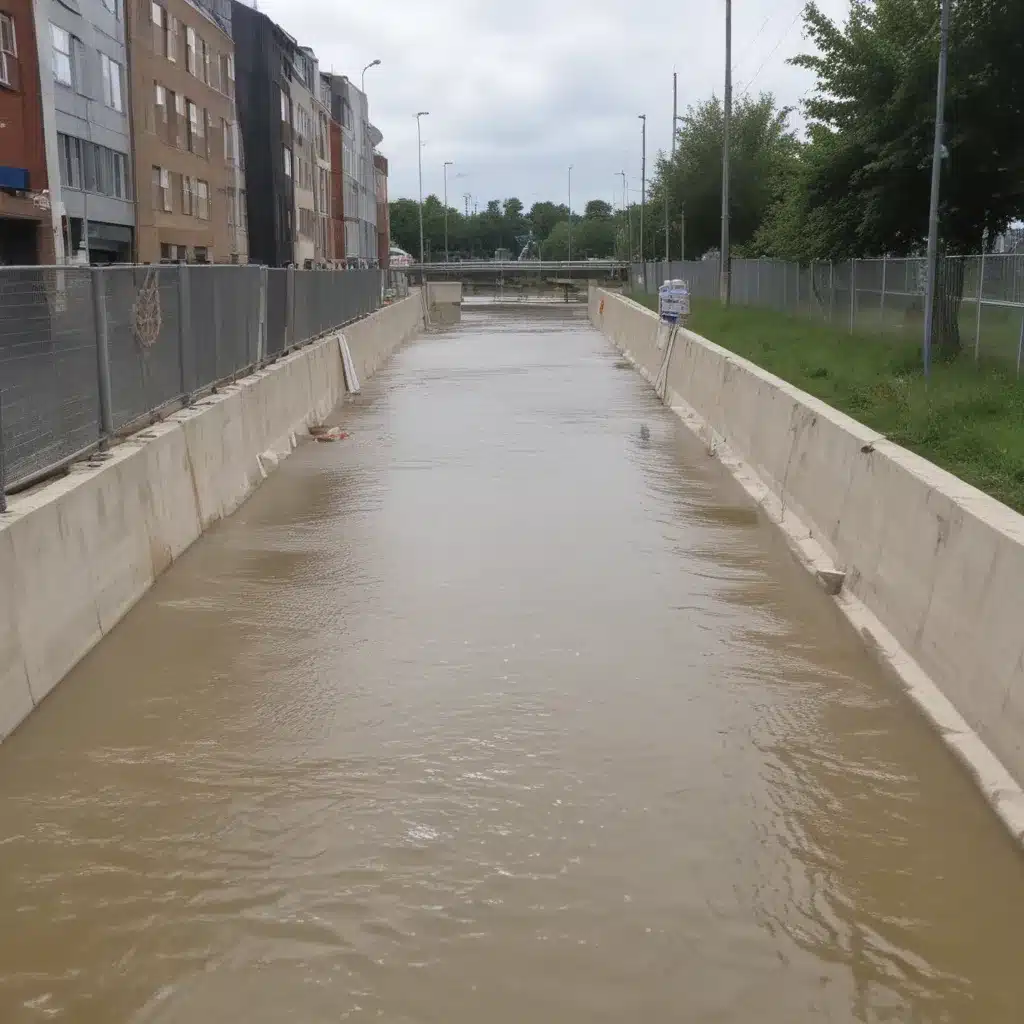
As a flood control specialist, I’ve had the privilege of working on a wide range of projects that safeguard communities and vital infrastructure against the devastating impacts of flooding. In this article, I’ll delve into the cutting-edge flood barrier systems that are transforming the way we protect our most critical assets.
Protecting Power Grids and Electrical Substations
Keeping the lights on during extreme weather events is a top priority, and innovative flood barrier solutions are playing a crucial role. Take the case of the Walham electrical switching substation in Gloucestershire, UK. As floodwaters threatened to inundate this critical facility, which provides power to over 600,000 residents and the nearby Government Communications Headquarters (GCHQ), a rapid response team sprang into action.
They deployed a temporary Geodesign flood barrier system around the substation, creating a robust barrier against the rising waters. These easily assembled, high-strength barriers proved to be a “game-changer,” according to the local distribution manager, helping to avert a prolonged power outage for thousands of homes and businesses. The success of this deployment has since prompted a broader re-evaluation of flood defense strategies by National Grid and other power providers.
Safeguarding Transportation Networks
Flood events can also wreak havoc on our transportation infrastructure, from flooded roads and rail lines to damaged bridges and tunnels. Mitigating these risks requires innovative, adaptable solutions. One such approach is the use of inflatable dams that can be rapidly deployed to protect low-lying roadways and underpasses.
These dams, made of durable, lightweight materials, can be quickly filled with air or water to create a temporary barrier against rising floodwaters. Their modular design allows them to be configured to fit a variety of locations, making them a versatile option for transportation agencies.
In addition to these inflatable barriers, amphibious structures are another innovative solution being explored. These are buildings or facilities designed to float on the water’s surface, rising and falling with the flood levels, ensuring continued operation even during extreme inundation events.
Protecting Water Treatment Facilities
Ensuring the uninterrupted operation of water treatment and distribution systems is essential for public health and safety. Deployable flood barriers have proven incredibly effective in shielding these critical facilities from the ravages of floods.
Take the example of the Tampa Bay Hospital during Hurricane Helene in 2024. As the facility faced the threat of devastating storm surge, they turned to the AquaFence, a state-of-the-art flood defense system. The FloodWall, a flexible, modular barrier, was rapidly deployed to create a watertight perimeter around the hospital, safeguarding the essential equipment and infrastructure within.
The versatility and adaptability of the AquaFence system allowed the hospital to quickly respond to the dynamic emergency situation, showcasing the vital role that innovative flood control technologies can play in protecting our most critical assets.
Harnessing Technological Advancements
The flood control industry has witnessed a remarkable surge in technological innovations, from advanced sensor networks to predictive analytics and automated control systems. These cutting-edge tools are transforming the way we assess, mitigate, and respond to flood risks.
Sensor networks, for instance, can provide real-time monitoring of water levels, precipitation, and other critical data, allowing for early warning systems and proactive deployment of flood barriers. Predictive analytics, powered by sophisticated weather modeling and machine learning algorithms, can help forecast flood events with greater accuracy, enabling emergency responders to act swiftly and effectively.
Automation and control systems, integrated with these monitoring and forecasting capabilities, can even trigger the deployment of deployable flood barriers at the first signs of a looming flood, ensuring critical infrastructure is protected before the waters rise.
Considering Environmental Impacts
As we embrace these innovative flood control solutions, it’s crucial to maintain a keen eye on the environmental implications. Flood mitigation efforts might want to be carefully designed and implemented to minimize any adverse impacts on local ecosystems.
Ecological impact assessments are essential in evaluating the potential effects of flood control infrastructure on habitats, species, and natural processes. By integrating engineering and ecological principles, we can develop holistic solutions that not only protect critical assets but also preserve and restore valuable environmental resources.
Furthermore, as the threat of climate change looms, our flood control strategies might want to evolve to address the increasing frequency and intensity of extreme weather events. Adaptation measures, such as the strategic placement of living shorelines, wetland restoration, and nature-based flood barriers, can enhance the resilience of both built and natural environments.
Conclusion
The protection of our critical infrastructure against the ravages of flooding is a complex and multifaceted challenge. However, the innovative flood barrier systems and technological advancements I’ve outlined in this article demonstrate the remarkable progress being made in this field.
By harnessing the power of deployable barriers, amphibious structures, and sensor-driven automation, we can safeguard our power grids, transportation networks, and water treatment facilities, ensuring the continuity of essential services during even the most extreme weather events.
Moreover, by considering the environmental impacts and embracing sustainable water management practices, we can develop flood control solutions that not only protect our critical assets but also enhance the resilience of our communities and the natural ecosystems that sustain them.
To stay up-to-date on the latest flood control technologies and best practices, I encourage you to visit Flood Control 2015 – a comprehensive resource for industry professionals, government agencies, and community stakeholders. Together, we can build a more resilient and sustainable future, one flood barrier at a time.
Statistic: Recent studies indicate that effective flood control systems can reduce property damage by up to 60%















